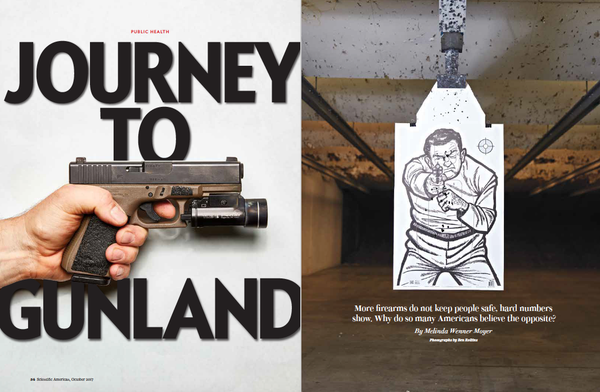The Objection
John R. Lott, Jr., PhD, president of the Crime Prevention Research Center in Swarthmore, Pa., writes:
Melinda Wenner Moyer’s article “Journey to Gunland” (October 2017) is very biased and ignores virtually all of the literature on right-to-carry laws and gun ownership since 1998. About two thirds of the peer-reviewed, published literature shows concealed carry laws help reduce crime. I even provided Moyer with those published papers, but she doesn’t provide a single reference to or quote from them. Moyer appears completely unaware any of my research after 1998, making no mention of the 2nd and 3rd editions of More Guns, Less Crime (University of Chicago Press, 2000, 2010).
On supporting science journalism
If you're enjoying this article, consider supporting our award-winning journalism by subscribing. By purchasing a subscription you are helping to ensure the future of impactful stories about the discoveries and ideas shaping our world today.
Moyer cites the National Research Council (NRC), but fails to accurately describe its findings. The council was more supportive of right-to-carry laws than it was of any other gun law. As is typical of NRC reports, the 2005 “Firearms and Violence” by the council refrained from endorsing any of the over 100 different gun regulations it studied.
However, there was one unexpected dissent by preeminent criminologist James Q. Wilson. Dissents in NRC reports are extremely rare. In the 10 years prior to the NRC report there were only two dissents out of 236 reports. Wilson, who had always supported gun control, had been on four previous panels but never had written a dissent. Finally, however, he pointed out the NRC’s own regressions consistently show right-to-carry laws reduce murder rates.
Moyer quotes physician Garen Wintemute: “Few studies…suggest that liberalizing access to concealed firearms has, on balance, beneficial effects.” But Moyer ignores 24 peer-reviewed publications just showing that crime in the U.S. drops after people are allowed to carry concealed handguns.
She references a recent unpublished paper by John Donohue, Abhay Aneja and Kyle Weber, but, unlike other studies, they don’t measure the number of permits issued, account for any other gun-control laws or deal with well-known statistical errors (such as truncation problems from a lot of zero values in the crime rates). The study also relies almost exclusively on trends in Hawaii to predict violent crime rates in Idaho, Minnesota, Mississippi, Nebraska and Utah.
Take one example of Moyer’s sloppiness or bias in her article. Moyer has a long discussion of Arthur Kellermann’s work on the risks of guns in the home, and notes that Kellermann studied “444 people who had been killed between 1987 and 1992 at home.” But Moyer fails to note that, in fact, in onlyeight of these 444 homicide cases was the murder weapon a gun that had been kept in the home (The New England Journal of Medicine, February 3, 1994, p. 368).If Moyer had even read the 1998 edition of More Guns, Less Crime, she would have learned this.
The Rebuttal
Melinda Wenner Moyer responds:
John R. Lott, Jr., is wrong in his claims. He asserts “two thirds of the peer-reviewed, published literature shows that concealed carry laws help reduce crime.” This figure comes from a 2012 paper Lott himself wrote for the Maryland Law Review. In it he asserts that 18 peer-reviewed studies show right-to-carry laws reduce violent crime but only 11 suggest a different result.
But his two-thirds claim is false. Many of these 18 supposed pro-carry studies are off-topic. One is a paper by Lott on gun storage laws that has nothing to do with concealed carry. A second paper investigates how abortion relates to crime, a third concerns laws that prevent minors from owning guns—again, irrelevant to concealed carry. Lott also includes the second edition of his own book as one of these 18 peer-reviewed studies.
In total, one third of his pro–concealed-carry citations refer to his own work. Not only does Lott inflate the number of studies that support his thesis, but he also completely omits many peer-reviewed studies that belong on the other side.
Lott is also wrong in his contention that I ignore 24 peer-reviewed publications “showing that crime in the U.S. drops after people are allowed to carry concealed handguns.” Included among these 24, which are listed on his Web site, are the irrelevant papers mentioned above, as well as other studies that do not show links between concealed carry policies and low crime. One of them, for example, is a paper on the relationship between crime and subscriptions to Handguns magazine.
Lott’s inaccuracies certainly do not reflect the true weight of the evidence. My investigation involved far more than the impact of concealed-carry laws and ultimately concluded that more guns—period—are associated with more crime and violence.
Lott mistakenly states that I did not mention that one National Research Council committee member dissented from the committee’s conclusion that “it is not possible to determine that there is a causal link between the passage of right-to-carry laws and crime rates.” I did, in fact, state in my piece that the vote was not unanimous. And 14 of the 15 members did agree with the committee conclusion, a fact Lott ignores. Clearly an overwhelming consensus had been reached among the researchers.
Finally, Lott criticizes me for omitting a detail about the Kellerman study that he considers important—but it is not. The study found the odds of being murdered nearly tripled among those who kept guns at home. Lott says it is important that most of these homicides did not involve the resident’s gun. That is a straw man. The study was designed to assess the relationship between keeping a gun in the home and the risk of being murdered by any weapon. Murder victims are murder victims, regardless of weapon or means.
Editor's note: Readers can examine the research studies of John R. Lott for themselves on his website: https://crimeresearch.org/2014/11/do-right-to-carry-laws-reduce-violent-crime/
